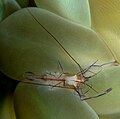
Sulawesi, also known as Celebes, is an island in Indonesia. One of the four Greater Sunda Islands, and the world's eleventh-largest island, it is situated east of Borneo, west of the Maluku Islands, and south of Mindanao and the Sulu Archipelago. Within Indonesia, only Sumatra, Borneo, and Papua are larger in territory, and only Java and Sumatra have larger populations.
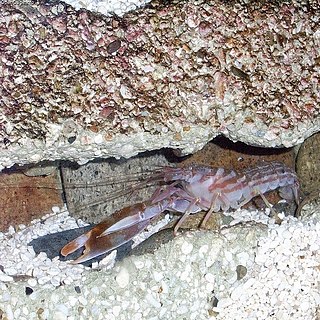
Alpheidae is a family of caridean snapping shrimp, characterized by having asymmetrical claws, the larger of which is typically capable of producing a loud snapping sound. Other common names for animals in the group are pistol shrimp or alpheid shrimp.

Lore Lindu National Park is a protected area of forest on the Indonesian island of Sulawesi, in the province of Central Sulawesi. The Indonesian national park is 2,180 km2 covering both lowland and montane forests. It provides habitat to numerous rare species, including 77 bird species endemic to Sulawesi. The national park is designated as part of the UNESCO World Network of Biosphere Reserves. In addition to its rich wildlife, the park also contains megaliths dating from before 1300 AD.

Isis hippuris, also known as sea bamboo, is a species of bamboo coral found in the Western Pacific Ocean, commonly near the coasts of Indonesia. I. hippuris reproduce asexually, and is abundant throughout its habitats in Indonesia. For centuries, I. hippuris has been identified by its bamboo or bony-looking structure. Additionally, it is notable for producing Hippuristanol, a molecule that could potentially have anti-cancer applications. While no actual conclusion regarding Hippuristanol in I. hippuris has been published, scientists and marine biologists continue to study how the molecule could be used in cancer research and recovery. Although only found in the Western Pacific Ocean, I. hippuris is highly sought after across the globe, and is seen as a symbol of beauty.

Wakatobi Regency is a group of ca. 150 islands forming an administrative regency located in Southeast Sulawesi Province of Indonesia. The four largest islands are Wangi-wangi, Kaledupa, Binongko and Tomia. The capital of the regency is located on Wangi-wangi Island, and was established by virtue of Law of the Republic of Indonesia Number 29 of 2003 dated 18 December 2003. The regency has an area of 473.62 square kilometres and had a population of 92,922 at the 2010 Census and 111,402 at the 2020 Census; the official estimate as at mid 2022 was 115,286 - comprising 57,662 males and 57,624 females.

Linckia laevigata is a species of sea star in the shallow waters of tropical Indo-Pacific.

Taenianotus is a monotypic genus of marine ray-finned fish belonging to the family Scorpaenidae, the scorpionfishes. Its only species is Taenianotus triacanthus, the leaf scorpionfish, paperfish, paper scorpionfish, sailfin leaffish or threespine scorpionfish. This taxon has a wide Indo-Pacific distribution.

Chromodoris annae also known as the Anna's magnificent sea slug is a species of sea slug, a very colourful nudibranch, a shell-less marine gastropod mollusc in the family Chromodorididae.

Hypselodoris tryoni is a species of sea slug, a dorid nudibranch, a marine gastropod mollusk in the genus Chromodorididae.

Pseudanthias pleurotaenia also known as the squarespot anthias, pink square anthias, mirror basslet or squarespot fairy basslet is a species of marine ray-finned fish in the subfamily Anthiinae of the family Serranidae, the groupers and sea basses. This species of Pseudanthias is a reef dwelling fish of the Pacific Ocean. It occasionally makes its way into the aquarium trade and grows to a size of 20 cm in length. The males are deep pink and orange in colour with a large quadrilateral purplish blotch on the flank, a red tip on the posterior margin of the dorsal fin, the caudal fin lobes have mauve tips and there is a reddish stripe which runs from the snout through the eye and through the base of the pectoral fin to the base of the tail. Females and juveniles are yellowish in colour with orange edges to their scales and they have two purple stripes which run from the eye along the lower flanks to the base of the tail.

The longnose hawkfish is a species of marine ray-finned fish, a hawkfish belonging to the family Cirrhitidae. It is found on tropical reefs of the Indian Ocean and the Pacific Ocean, where it can be found at depths around 10 to 100 m. It prefers the steep outer slopes of the reefs amongst gorgonians and black corals. This species can reach 13 cm (5.1 in) in total length. It can also be found in the aquarium trade. It is currently the only known member in its genus.

Bunaken National Park is a marine park in the north of Sulawesi island, Indonesia. The park is located near the centre of the Coral Triangle, providing habitat to 390 species of coral as well as many fish, mollusc, reptile and marine mammal species. The park is representative of Indonesian tropical water ecosystems, consisting of seagrass plain, coral reef, and coastal ecosystems.

Taka Bonerate National Park is a marine park which includes the Takabonerate atoll islands, located in the Flores Sea, south of Sulawesi island of Indonesia.
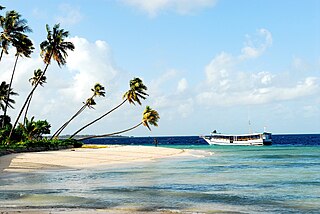
Wakatobi National Park is a marine national park in Southeast Sulawesi, Indonesia. The name of Wakatobi is a portmanteau of the four main Tukangbesi Islands: Wangi-wangi, Kaledupa, Tomia, and Binongko. Since 2005 the park is listed as a tentative World Heritage Site.

Galaxea fascicularis is a species of colonial stony coral in the family Euphylliidae, commonly known as octopus coral, fluorescence grass coral, galaxy coral among various vernacular names.

Ancylomenes is a genus of shrimp, erected in 2010 to accommodate the group of species around "Periclimenes aesopius". Members of the genus are widely distributed in the warm oceans of the world, and live in association with cnidarians; most are cleaner shrimp.

Paragobiodon is a genus of gobies native to reef habitats of the Indian Ocean and the western Pacific Ocean.

The Wakatobi flowerpecker is a subspecies of the grey-sided flowerpecker that is endemic to the Wakatobi Islands of Indonesia. Some authorities consider it to be a separate species as Dicaeum kuehni.
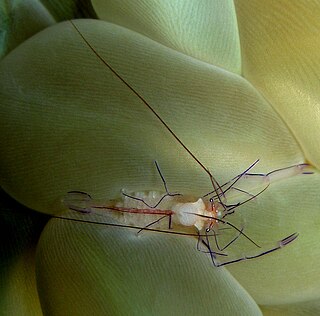
Vir is a genus of shrimp comprising the following species:
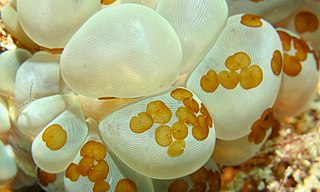
Waminoa is a genus of acoels which are epizoic on living corals, using the coral's mucus as a source of food. Unusually, these acoels harbor two genera of endosymbiotic dinoflagellates: Symbiodinium and Amphidinium; it is not typical for two different genera of dinoflagellates to coexist in a single host. Waminoa's host coral may also contain dinoflagellates of the genus Symbiodinium but not Amphidinium.


